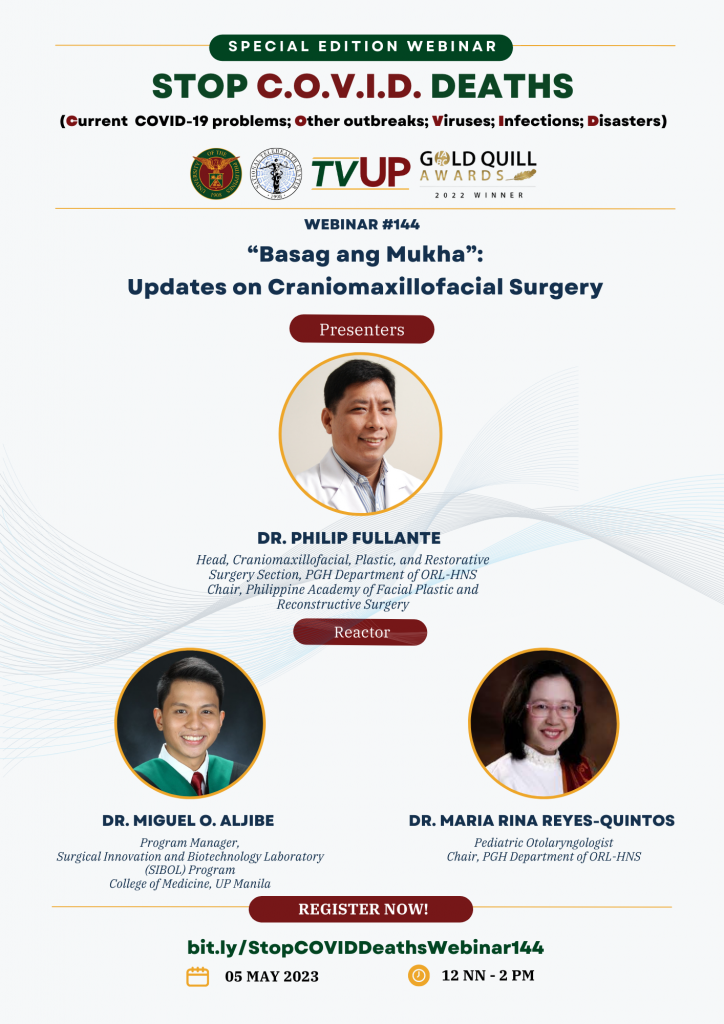
- This event has passed.
Stop COVID Deaths Webinar #144 “Basag ang Mukha”: Updates on Craniomaxillofacial Surgery

The University of the Philippines in partnership with
UP Manila-NIH National Telehealth Center and in cooperation with
UP Philippine General Hospital and
UP College of Medicine
would like to invite you to join the Fight Against COVID-19!
Registration slots are limited to this SPECIAL EDITION of
the STOP C.O.V.I.D. DEATHS Webinar Series.
(Current COVID-19 problems; Other outbreaks; Viruses; Infections; Disasters)
So sign up NOW:
bit.ly/StopCOVIDDeathsWebinar144
Webinar #144
3rd Anniversary
May 5, 2023 (Friday) 12nn
“Basag ang Mukha”: Updates on Craniomaxillofacial Surgery
Presenter:
DR. PHILIP B. FULLANTE
Head, Craniomaxillofacial, Plastic, and Restorative Surgery Section
PGH Department of ORL-HNS
Chair, Philippine Academy of Facial Plastic and Reconstructive Surgery
Reactors:
DR. MARIA RINA T. REYES-QUINTOS
Pediatric Otolaryngologist
Chair, PGH Department of ORL-HNS
DR. MIGUEL O. ALJIBE
Program Manager, Surgical Innovation and Biotechnology Laboratory (SIBOL) Program
College of Medicine, UP Manila
Synthesis & Closing Remarks:
DR. STELLA MARIE L. JOSE
Head, Office of Expanded Education and Training
UP Philippine General Hospital
———————————————————–
May 5, 2023 (Friday) 12nn
Webinar #144
“Basag ang Mukha”: Updates on Craniomaxillofacial Surgery
All of us have a unique face that is critical to our identity and self-esteem. Women look at their faces 34-40 times a day. Men look at their faces a bit less, perhaps 25-30 times a day. The face, head, and neck play important roles in human interactions, including during social activities. Moreover, the face is one of the most fundamental parts of the body for self-recognition. Vision, hearing, smell, eating, and breathing are considered the primary functions of the face. People who experience facial deformities due to trauma, tumors or congenital defects may possess a negative self-image compared to normal individuals. This trend of thinking negatively influences social activity and productivity.
The facial skeleton consists of 14 bones with different anatomic structures and embryological formations. These bones comprise the paired nasal bones, inferior nasal conchae, palatine bones, maxillae, zygomatic bones, lacrimal bones, and the unpaired mandible and vomers. Injury to any of these bones may impact on the adjacent bones. The surgical correction of deformities is challenging. The success of these surgeries depends on surgical skill, but more importantly, planning of an interdisciplinary team that includes engineers, fine arts experts, anesthesiologists guides the work of the surgeon. Additive manufacturing technologies have enabled the development of customized implants for craniomaxillofacial applications using biomaterials.
In this episode of STOP COVID Deaths we will take a closer look at types of craniomaxillofacial injuries, deformities, and tumors as well as the state of the art in management and care at the Philippines General Hospital presented by the Department of Otorhinolaryngology – Head and Neck Surgery (ORL-HNS). Our main presenter is Dr. Philip Fullante, Head of the Craniomaxillofacial, Plastic, and Restorative Surgery Section, who will be talking about surgical simulation training, prosthetics, and patient-specific point-of-care services. Our reactors are Dr. Maria Rina Reyes-Quintos, Chair of the Department of ORL-HNS, who will discuss the state-of-the-art care and management for craniomaxillofacial surgery patients and Dr. Miguel Aljibe, Program Manager for the UP College of Medicine’s Surgical Innovation and Biotechnology Laboratory (SIBOL) Program, who will be talking about the collaboration of the UP College of Medicine with UP College of Engineering and UP College of Fine Arts. The Synthesis and Closing Remarks will be delivered by Dr. Stella Marie L. Jose, who is the PGH Head of the Office of Expanded Education and Training.
Join us as we learn about updates on craniomaxillofacial surgery. Together, we can STOP C.O.V.I.D. DEATHS!
